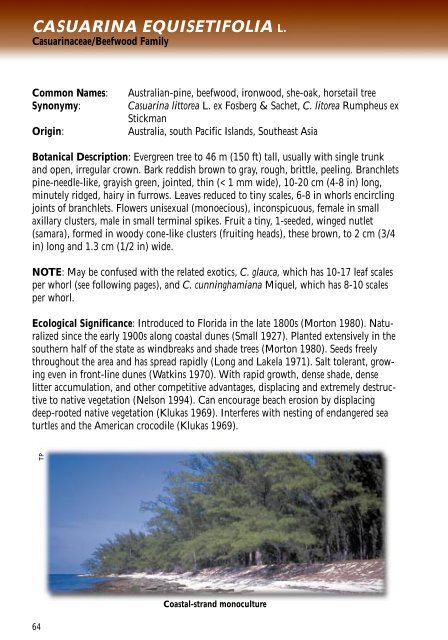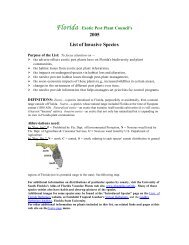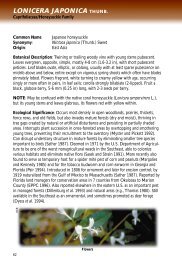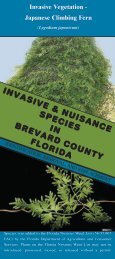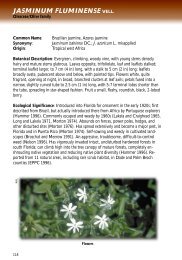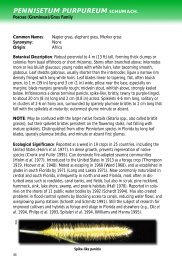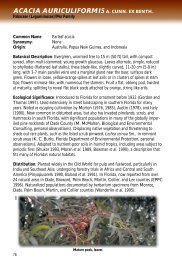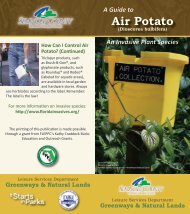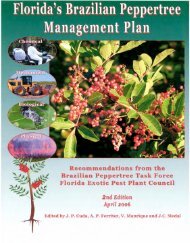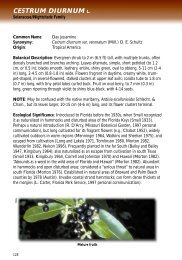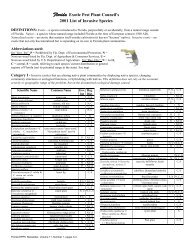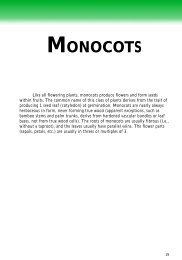DICOTS - Florida Exotic Pest Plant Council
DICOTS - Florida Exotic Pest Plant Council
DICOTS - Florida Exotic Pest Plant Council
Create successful ePaper yourself
Turn your PDF publications into a flip-book with our unique Google optimized e-Paper software.
Casuarina equisetifolia L.<br />
Casuarinaceae/Beefwood Family<br />
Common Names: Australian-pine, beefwood, ironwood, she-oak, horsetail tree<br />
Synonymy: Casuarina littorea L. ex Fosberg & Sachet, C. litorea Rumpheus ex<br />
Stickman<br />
Origin: Australia, south Pacific Islands, Southeast Asia<br />
Botanical Description: Evergreen tree to 46 m (150 ft) tall, usually with single trunk<br />
and open, irregular crown. Bark reddish brown to gray, rough, brittle, peeling. Branchlets<br />
pine-needle-like, grayish green, jointed, thin (< 1 mm wide), 10-20 cm (4-8 in) long,<br />
minutely ridged, hairy in furrows. Leaves reduced to tiny scales, 6-8 in whorls encircling<br />
joints of branchlets. Flowers unisexual (monoecious), inconspicuous, female in small<br />
axillary clusters, male in small terminal spikes. Fruit a tiny, 1-seeded, winged nutlet<br />
(samara), formed in woody cone-like clusters (fruiting heads), these brown, to 2 cm (3/4<br />
in) long and 1.3 cm (1/2 in) wide.<br />
NOTE: May be confused with the related exotics, C. glauca, which has 10-17 leaf scales<br />
per whorl (see following pages), and C. cunninghamiana Miquel, which has 8-10 scales<br />
per whorl.<br />
Ecological Significance: Introduced to <strong>Florida</strong> in the late 1800s (Morton 1980). Naturalized<br />
since the early 1900s along coastal dunes (Small 1927). <strong>Plant</strong>ed extensively in the<br />
southern half of the state as windbreaks and shade trees (Morton 1980). Seeds freely<br />
throughout the area and has spread rapidly (Long and Lakela 1971). Salt tolerant, growing<br />
even in front-line dunes (Watkins 1970). With rapid growth, dense shade, dense<br />
litter accumulation, and other competitive advantages, displacing and extremely destructive<br />
to native vegetation (Nelson 1994). Can encourage beach erosion by displacing<br />
deep-rooted native vegetation (Klukas 1969). Interferes with nesting of endangered sea<br />
turtles and the American crocodile (Klukas 1969).<br />
TP<br />
64<br />
Coastal-strand monoculture


